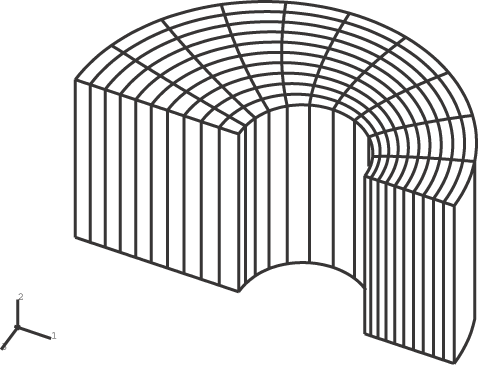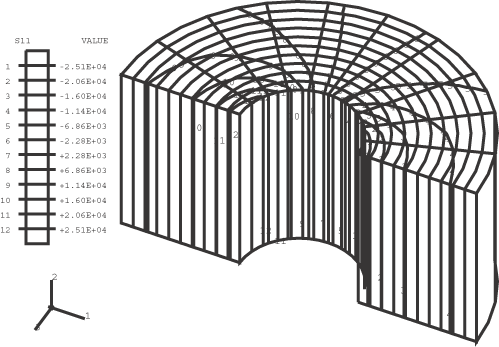Elements tested
CAXA4n
CAXA4Rn
CAXA8n
CAXA8Rn
(n = 1, 2, 3, 4)
ProductsAbaqus/Standard Elements testedCAXA4n CAXA4Rn CAXA8n CAXA8Rn (n = 1, 2, 3, 4) Problem description
where Only a slice of the cylinder is considered. Plane strain conditions are applied by setting 0 everywhere. In the r-direction 10 elements are used in the second-order element models. In models using the first-order elements, 20 and 40 elements are used in the full- and reduced-integration models, respectively. Material:Linear elastic, Young's modulus = 30 × 106, Poisson's ratio = 0.3. Boundary conditions:0 everywhere; −9.9854 × 10−4 at and 0°, as obtained from the equation for above. These constraints eliminate the rigid body motions in the global z- and x-directions, respectively. Loading:The asymmetric pressure loads are prescribed by applying the appropriate nonuniform distributed load types on the inside and outside surfaces of the cylinder and defining the pressure stress equations for in user subroutine DLOAD. In the user subroutine, the value at each integration point, which is stored in Results and discussionThe analytical solution and the Abaqus results for the CAXA8n, CAXA8Rn, CAXA4n, and CAXA4Rn (n = 1, 2, 3 or 4) elements are tabulated below for a cylinder with these parameters: 6, 2, 6, and 10 × 103. The output locations are at points and on the 0° plane, where z can be any value along lines and in the figure shown on the previous page since the solution is independent of z, and at points E and G, which are at the corresponding locations on the 180° plane. The solutions predicted by Abaqus agree well with the exact solution. Closer agreement is anticipated if a denser mesh is used.
Note:
The results are independent of n, the number of Fourier modes. The variable is not compared, since is treated as an internal variable in these elements and is not available for output. The accuracy of may be assumed to be comparable to the accuracy of . Figure 1 through Figure 4 show plots of the undeformed mesh, the deformed mesh, the contours of , and the contours of , respectively, for the CAXA8R3 model. Input files
Figures    | |||||||||||||||||||||||||||||||||||||||||||||||||||||||||||||||||||||||||||||||||||||||||||||||||||||||||||||||||||||||||||||||||||||